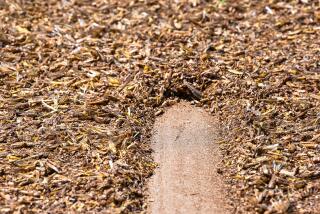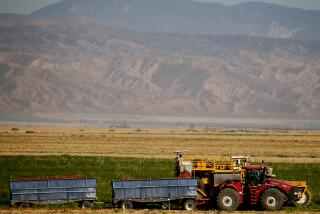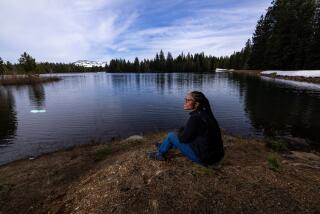The Last Roundup? : Cattlemen Face Threat of Higher Fees for Use of Public Lands
- Share via
Bill King’s family has been raising cattle in the rugged canyons above Piru since before the 74-year-old King was born, before the dry and scraggly land was christened the Los Padres National Forest.
Although much of the land is government property, King has cared for it as if it were his own, building fences, clearing 20-foot-high brush, repairing roads and keeping an eye out for troublemakers.
“This business about the cattleman getting a free ride on the forest, the government land--that’s a myth,” King said.
But the federal government wants to raise fees and increase regulations on cattle grazing on public lands--a move that may drive up the costs of doing business and threaten the existence of one of Ventura County’s oldest industries.
While the proposal has provoked the rancor of cattle ranchers, it has gained only tepid support from environmentalists.
Jay Watson, the Wilderness Society’s regional director for California and Nevada, said the government is not going far enough to protect public lands from the damage that can result from intensive cattle grazing, including erosion and destruction of sensitive wildlife habitats.
“There’s a lot at stake,” Watson said. “I want to see a balance struck between providing for ranching as a way of life to continue in the West--because it is a part of the West--and protecting the quality of what remains of the American landscape.”
But the proposed grazing regulations, he said, are “quite toothless.”
Even some ranchers agree that the precise impact of the government proposal is hard to decipher. “It’s going to take a Philadelphia lawyer to figure this out,” said Bud Botello, a 66-year-old rancher with a small cattle operation near Lake Casitas.
One thing is clear: The 15 Ventura County ranchers who have 700 cattle grazing in the Los Padres National Forest would see their payments to the government double over the next few years.
By 1997, the fees would rise from $1.98 to $3.96 per “animal-unit month,” a measure defined as the grazing needs of a cow and her calf for one month.
Bill King has 300 cows, steers, bulls and heifers roaming the canyons at the lower edge of the forest near Lake Piru.
If all of King’s cattle were grazing solely in public lands, his yearly fees under the new regulations would come to more than $14,000.
But half the land within the national forest boundaries is privately owned.
And King’s cattle graze over a crazy quilt of property, with some patches owned by King himself and other large swaths owned by private interests such as Texaco Inc.
Of the roughly 16,000 acres that King leases as rangeland, only about 10,000 are part of the national forest.
And only 20% of the forest land is cleared enough to be accessible to cattle.
So King pays grazing fees for only about 25 cattle per month, based on a calculation of how much time per month his cattle spend on public land.
His fees to the government under the proposed regulations would double from about $620 to $1,200 per year.
Such an increase may not seem like a lot, but cattle ranchers say they are more worried about the possible hidden costs of the proposed regulations.
Under the proposal--which Department of Agriculture officials will decide on after public hearings this summer--ranchers would pay a greater, though undetermined, share of the costs of protecting sensitive wildlife habitats that may be trampled by grazing cattle.
King, Botello and other Ventura County ranchers may, for example, have to pay to fence off sections of creeks that are known habitats for threatened or endangered species, such as the arroyo toad or the red-legged frog, said DeLoy Esplin, a spokesman for the U.S. Forest Service’s office in Goleta, which manages the Los Padres National Forest.
And ranchers may also be required under the regulations to help pay for costly environmental reports monitoring the effect of their cattle grazing on the national forest.
Dan Macon, director of industry affairs for the California Cattlemen’s Assn., said the proposed regulations would put an unfair burden on the cattlemen to maintain national forests that many other people use.
“He shares that land with backpackers, hikers, fishermen,” Macon said, “and those people are not paying anything for the use of that land.”
Environmentalists say the increased grazing fees and other charges proposed in the regulations reflect the true cost of raising cattle on public lands.
“Livestock grazing on public lands in some places is a tremendously destructive activity,” Watson of the Wilderness Society said.
But local forest service officials say Los Padres has been spared much of the damage that grazing has caused in some other areas of the country.
At one point in the early 1800s, livestock ranching was the region’s main industry.
Sprawling ranchos devoted to raising cattle and other livestock covered much of the area from Simi Valley to the coast.
Since a drought in the mid-1800s forced ranchers to sell or move most of their animals, cattle operations have been confined largely to remote areas, away from highways and encroaching development.
By the time the government took control of what is now the national forest in the early 1900s (creating the Los Padres National Forest in 1936), ranchers were already there.
Ventura County now has an estimated 45 ranchers raising about 10,000 head of cattle, but most are on private land.
And forest officials say they have monitored grazing in the national forest closely enough to prevent erosion or other significant damage.
“We feel that the grazing is being done at a conservative rate so that it can be done forever,” Esplin said.
But Rob Frost, president of the Ventura County Cattlemen’s Assn., said that if the costs of ranching rise too far, many cattle owners who rely on public lands may leave the business entirely or quit using public lands.
That, in turn, would deprive the public of the improvements that cattle ranchers make at Los Padres and on other government lands, ranchers say.
“They’re local residents who have eyes and ears that help to maintain the resource,” Esplin said. “I don’t look at them as damaging and destroying.”
More to Read
Sign up for Essential California
The most important California stories and recommendations in your inbox every morning.
You may occasionally receive promotional content from the Los Angeles Times.










